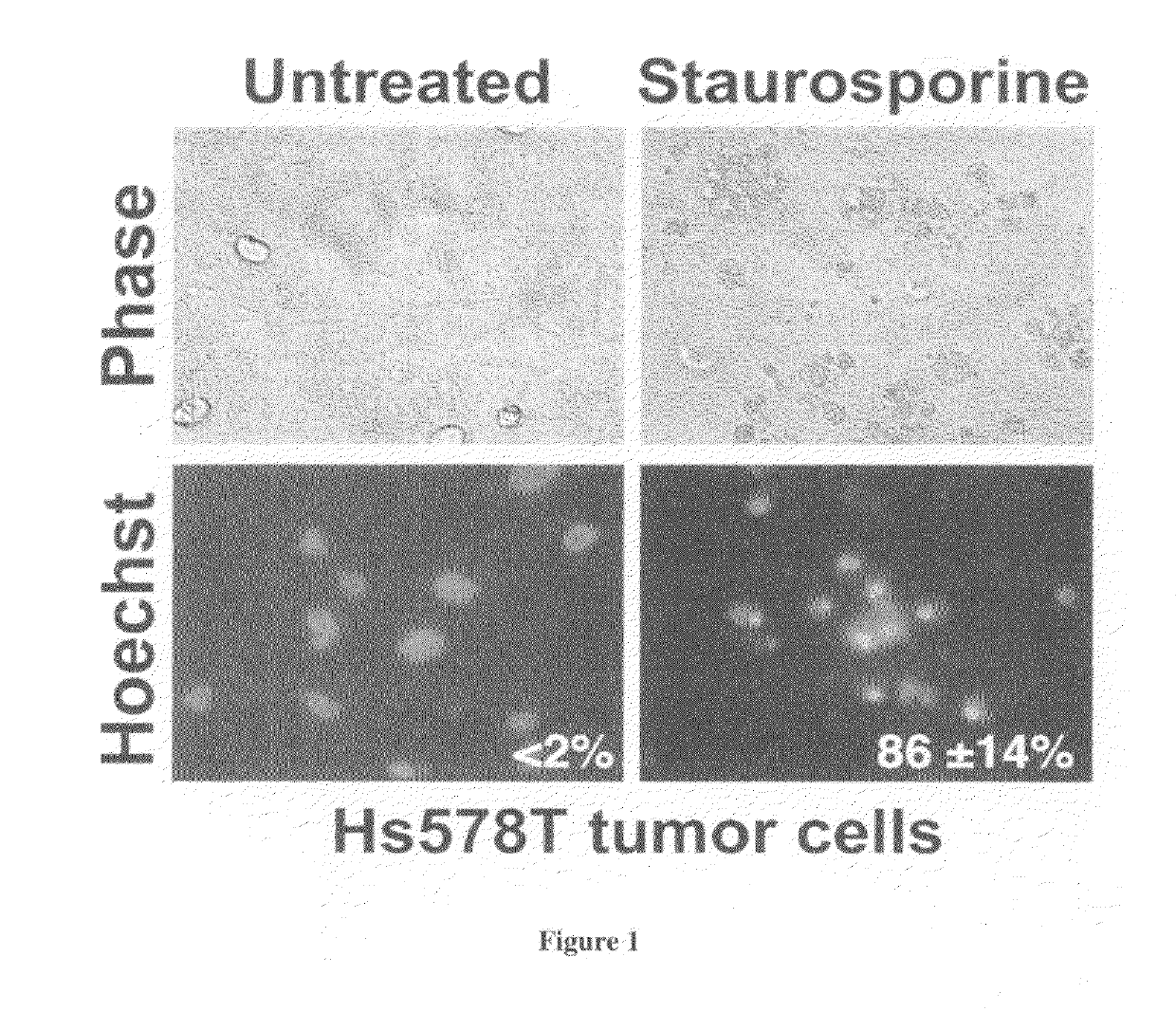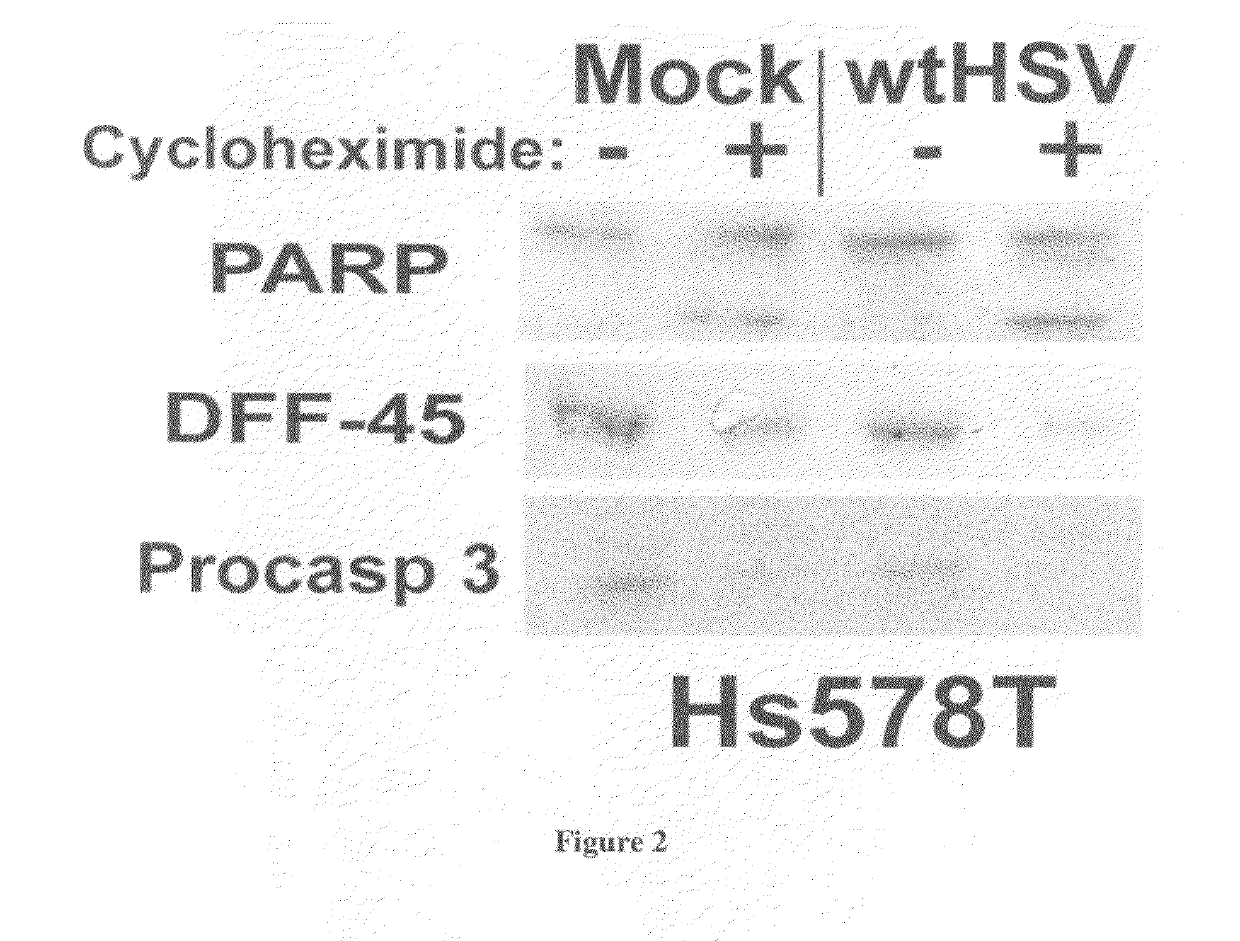Method of determining susceptibility of a tumor cell to a chemotherapeutic agent: novel use of herpes
a tumor cell and susceptibility technology, applied in the field of determining the susceptibility of tumor cells to a chemotherapeutic agent, can solve the problems of unsatisfactory need, long assay duration and lack of reliability, and undesirable applicability
- Summary
- Abstract
- Description
- Claims
- Application Information
AI Technical Summary
Benefits of technology
Problems solved by technology
Method used
Image
Examples
example 1
Herpes Simplex Virus Induces Apoptotic Killing in Tumor Cells
[0053]a) Tumor Cell Apoptosis
[0054]We have established an in vitro cell model and examined herpes simplex virus-induced apoptotic killing of tumor cells. In the first series of studies, we used a standard inducer of apoptotic killing. A protein kinase inhibitor (i.e., staurosporine) was used. Mammary tumor cells (Hs578T) were cultured and treated with staurosporine (0.1-2 μM) for about 12-18 hours. Staurosporine caused Hs578T cells to undergo morphological alternations consistent with apoptotic killing (i.e., cell shrinkage, chromatin condensation, and membrane blebbing) as compared to untreated cells. (FIG. 1). When this phenotype was quantified for three independent experiments, the staurosporine-treated Hs578T cells exhibited 86±14% chromatin condensation.
[0055]In addition, staurosporine caused drastic death factor processing [poly(ADP-ribose) polymerase, procaspase 3, and DNA fragmentation factor-45] in Hs578T cells (F...
example 2
HSVs Lacking Immediate Early Genes Induce Tumor Apoptotic Killing
[0062]Herpes simplex virus contains a total of five (5) immediate early genes, of which three (3) are essential for viral replication (i.e., ICP27, ICP4 and ICP22). We prepared ICP27-, ICP4-, and ICP22-null recombinant viruses (i.e., ΔICP27, ΔICP4, ΔICP22) using standard methods. (Sanfilippo et al. ICP0 gene expression is a HSV-1 apoptotic trigger. J. Virol. 78: 6810-6821, 2006). The characteristics of these deletion mutants are summarized in Table 2.
TABLE 2Herpes Simplex Virus Deletion MutantsHSV Deletion MutantsGenes DeletedCharacteristicsΔICP27UL54Defective in viral DNAsynthesis and late geneexpressionΔICP4Alpha4Defective in viral early andlate gene expressionΔICP22US1, alpha22Defective in viral late geneexpression
[0063]a) ΔICP27 Induces Apoptotic Killing in Tumor Cells
[0064]In this study, we examined whether herpes simplex virus lacking an immediate early gene (e.g., ΔICP27) would induce apoptotic killing of Hs578T...
example 3
HSV Induces Apoptotic Killing in Additional Tumor Cells
[0069]a) HSV Induces Apoptosis in Colon, Brain and Breast Tumor Cells
[0070]So far, we have demonstrated HSV induces apoptotic killing in Hs578T (mammary cancer cells) and HEp-2 cells (epithelial carcinoma). To gain further insight into the tumor cell determinants for susceptibility to HSV-induced apoptotic killing, we analyzed a selected group of tumor cells. In this study, we used both wtHSV-1 and ΔICP27 and representative tumor cells. Experiments were conducted using conditions described above. Table 4 summarizes the results using .ΔICP27:
TABLE 4Herpes Simplex Virus Induce Apoptotic Killing in Several Tumor CellsApoptotic Killing (measured bymorphological alternations and deathHSVTypes of Tumor Cellsfactor processingΔICP27Colon TumorHT-29+RKO+RKO-E6+Brain TumorSK-N-SH+Breast TumorMCF-7 / C3+
[0071]Similar results were obtained when wtHSV (in the presence of cycloheximide) was used (data not shown). From these results, we conclude...
PUM
| Property | Measurement | Unit |
|---|---|---|
| Electrical resistance | aaaaa | aaaaa |
| Chemotherapeutic properties | aaaaa | aaaaa |
Abstract
Description
Claims
Application Information
 Login to View More
Login to View More - R&D
- Intellectual Property
- Life Sciences
- Materials
- Tech Scout
- Unparalleled Data Quality
- Higher Quality Content
- 60% Fewer Hallucinations
Browse by: Latest US Patents, China's latest patents, Technical Efficacy Thesaurus, Application Domain, Technology Topic, Popular Technical Reports.
© 2025 PatSnap. All rights reserved.Legal|Privacy policy|Modern Slavery Act Transparency Statement|Sitemap|About US| Contact US: help@patsnap.com



